weight MERCEDES-BENZ GLK-Class 2012 X204 Owner's Manual
[x] Cancel search | Manufacturer: MERCEDES-BENZ, Model Year: 2012, Model line: GLK-Class, Model: MERCEDES-BENZ GLK-Class 2012 X204Pages: 316, PDF Size: 13.21 MB
Page 12 of 316
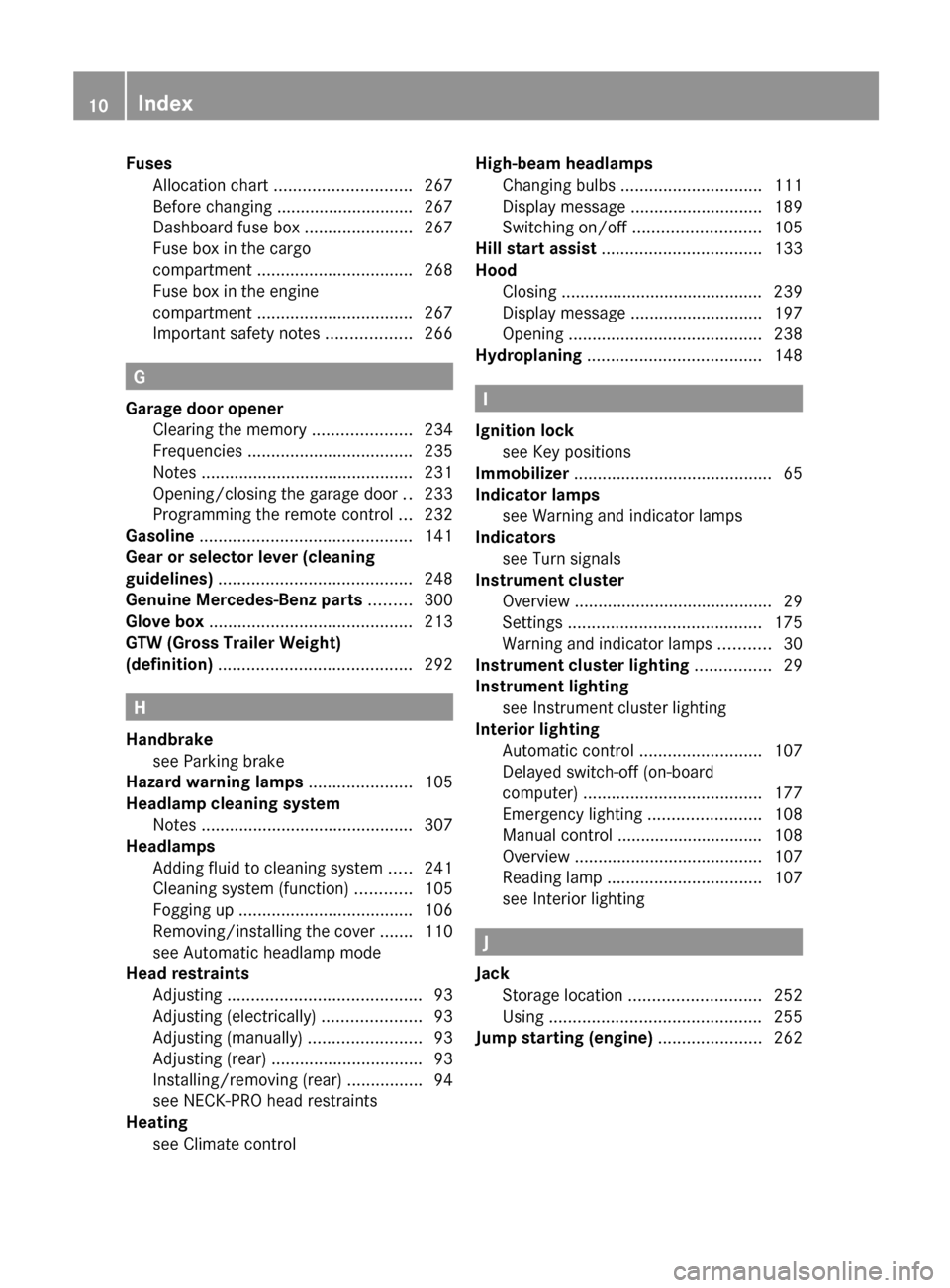
FusesAllocation chart ............................. 267
Before changing ............................. 267
Dashboard fuse box .......................267
Fuse box in the cargo
compartment ................................. 268
Fuse box in the engine
compartment ................................. 267
Important safety notes ..................266
G
Garage door opener Clearing the memory .....................234
Frequencies ................................... 235
Notes ............................................. 231
Opening/closing the garage door ..233
Programming the remote control ...232
Gasoline ............................................. 141
Gear or selector lever (cleaning
guidelines) ......................................... 248
Genuine Mercedes-Benz parts ......... 300
Glove box ........................................... 213
GTW (Gross Trailer Weight)
(definition) ......................................... 292
H
Handbrake see Parking brake
Hazard warning lamps ...................... 105
Headlamp cleaning system Notes ............................................. 307
Headlamps
Adding fluid to cleaning system .....241
Cleaning system (function) ............105
Fogging up ..................................... 106
Removing/installing the cover .......110
see Automatic headlamp mode
Head restraints
Adjusting ......................................... 93
Adjusting (electrically) .....................93
Adjusting (manually) ........................93
Adjusting (rear) ................................ 93
Installing/removing (rear) ................94
see NECK-PRO head restraints
Heating
see Climate control
High-beam headlamps
Changing bulbs .............................. 111
Display message ............................ 189
Switching on/off ........................... 105
Hill start assist .................................. 133
Hood Closing ........................................... 239
Display message ............................ 197
Opening ......................................... 238
Hydroplaning ..................................... 148
I
Ignition lock see Key positions
Immobilizer .......................................... 65
Indicator lamps see Warning and indicator lamps
Indicators
see Turn signals
Instrument cluster
Overview .......................................... 29
Settings ......................................... 175
Warning and indicator lamps ...........30
Instrument cluster lighting ................ 29
Instrument lighting see Instrument cluster lighting
Interior lighting
Automatic control ..........................107
Delayed switch-off (on-board
computer) ...................................... 177
Emergency lighting ........................108
Manual control ............................... 108
Overview ........................................ 107
Reading lamp ................................. 107
see Interior lighting
J
Jack Storage location ............................ 252
Using ............................................. 255
Jump starting (engine) ...................... 262
10Index
Page 19 of 316
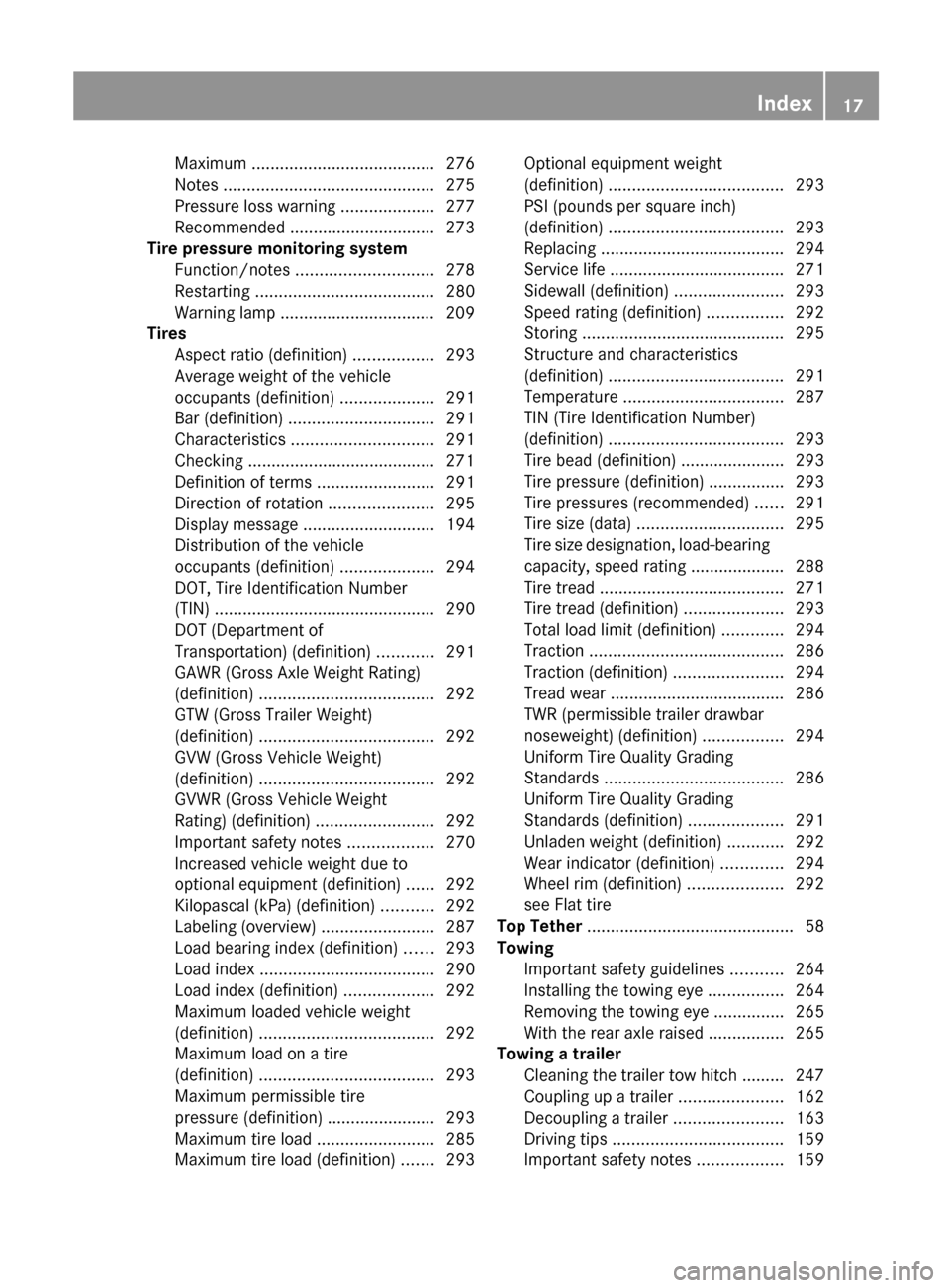
Maximum ....................................... 276
Notes ............................................. 275
Pressure loss warning ....................277
Recommended ............................... 273
Tire pressure monitoring system
Function/notes ............................. 278
Restarting ...................................... 280
Warning lamp ................................. 209
Tires
Aspect ratio (definition) .................293
Average weight of the vehicle
occupants (definition) ....................291
Bar (definition) ............................... 291
Characteristics .............................. 291
Checking ........................................ 271
Definition of terms .........................291
Direction of rotation ......................295
Display message ............................ 194
Distribution of the vehicle
occupants (definition) ....................294
DOT, Tire Identification Number
(TIN) ............................................... 290
DOT (Department of
Transportation) (definition) ............291
GAWR (Gross Axle Weight Rating)
(definition) ..................................... 292
GTW (Gross Trailer Weight)
(definition) ..................................... 292
GVW (Gross Vehicle Weight)
(definition) ..................................... 292
GVWR (Gross Vehicle Weight
Rating) (definition) .........................292
Important safety notes ..................270
Increased vehicle weight due to
optional equipment (definition) ......292
Kilopascal (kPa) (definition) ...........292
Labeling (overview) ........................287
Load bearing index (definition) ......293
Load index ..................................... 290
Load index (definition) ...................292
Maximum loaded vehicle weight
(definition) ..................................... 292
Maximum load on a tire
(definition) ..................................... 293
Maximum permissible tire
pressure (definition) ....................... 293
Maximum tire load .........................285
Maximum tire load (definition) .......293Optional equipment weight
(definition) ..................................... 293
PSI (pounds per square inch)
(definition) ..................................... 293
Replacing ....................................... 294
Service life ..................................... 271
Sidewall (definition) .......................293
Speed rating (definition) ................292
Storing ........................................... 295
Structure and characteristics
(definition) ..................................... 291
Temperature .................................. 287
TIN (Tire Identification Number)
(definition) ..................................... 293
Tire bead (definition) ......................293
Tire pressure (definition) ................293
Tire pressures (recommended) ......291
Tire size (data) ............................... 295
Tire size designation, load-bearing
capacity, speed rating .................... 288
Tire tread ....................................... 271
Tire tread (definition) .....................293
Total load limit (definition) .............294
Traction ......................................... 286
Traction (definition) .......................294
Tread wear ..................................... 286
TWR (permissible trailer drawbar
noseweight) (definition) .................294
Uniform Tire Quality Grading
Standards ...................................... 286
Uniform Tire Quality Grading
Standards (definition) ....................291
Unladen weight (definition) ............292
Wear indicator (definition) .............294
Wheel rim (definition) ....................292
see Flat tire
Top Tether ............................................ 58
Towing Important safety guidelines ...........264
Installing the towing eye ................264
Removing the towing eye ...............265
With the rear axle raised ................265
Towing a trailer
Cleaning the trailer tow hitch ......... 247
Coupling up a trailer ......................162
Decoupling a trailer .......................163
Driving tips .................................... 159
Important safety notes ..................159Index17
Page 20 of 316
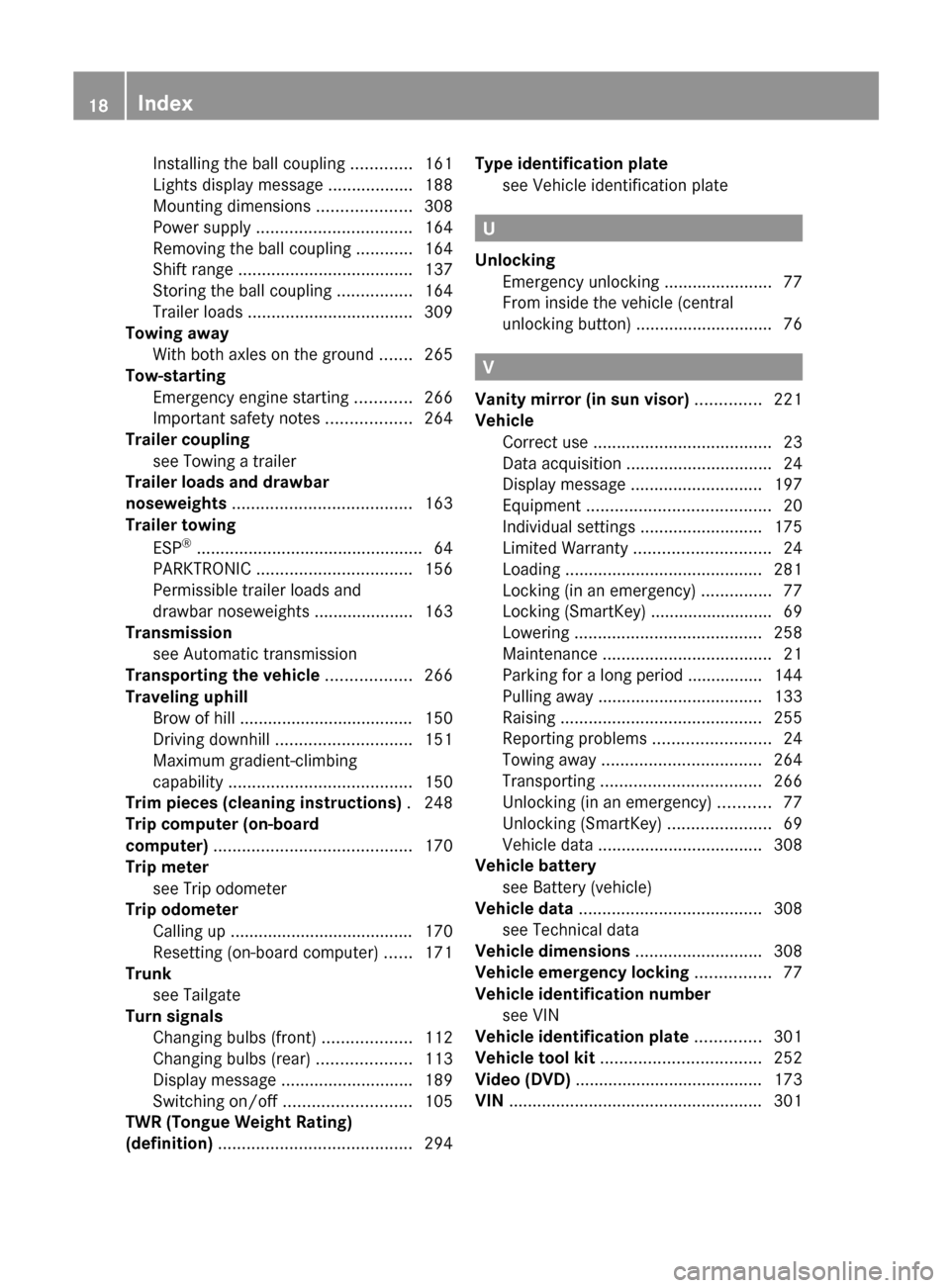
Installing the ball coupling .............161
Lights display message ..................188
Mounting dimensions ....................308
Power supply ................................. 164
Removing the ball coupling ............164
Shift range ..................................... 137
Storing the ball coupling ................164
Trailer loads ................................... 309
Towing away
With both axles on the ground .......265
Tow-starting
Emergency engine starting ............266
Important safety notes ..................264
Trailer coupling
see Towing a trailer
Trailer loads and drawbar
noseweights ...................................... 163
Trailer towing
ESP ®
................................................ 64
PARKTRONIC ................................. 156
Permissible trailer loads and
drawbar noseweights .....................163
Transmission
see Automatic transmission
Transporting the vehicle .................. 266
Traveling uphill Brow of hill ..................................... 150
Driving downhill ............................. 151
Maximum gradient-climbing
capability ....................................... 150
Trim pieces (cleaning instructions) . 248
Trip computer (on-board
computer) .......................................... 170
Trip meter see Trip odometer
Trip odometer
Calling up ....................................... 170
Resetting (on-board computer) ......171
Trunk
see Tailgate
Turn signals
Changing bulbs (front) ...................112
Changing bulbs (rear) ....................113
Display message ............................ 189
Switching on/off ........................... 105
TWR (Tongue Weight Rating)
(definition) ......................................... 294Type identification plate
see Vehicle identification plate
U
Unlocking Emergency unlocking .......................77
From inside the vehicle (central
unlocking button) ............................. 76
V
Vanity mirror (in sun visor) .............. 221
Vehicle Correct use ...................................... 23
Data acquisition ............................... 24
Display message ............................ 197
Equipment ....................................... 20
Individual settings ..........................175
Limited Warranty ............................. 24
Loading .......................................... 281
Locking (in an emergency) ...............77
Locking (SmartKey) .......................... 69
Lowering ........................................ 258
Maintenance .................................... 21
Parking for a long period ................ 144
Pulling away ................................... 133
Raising ........................................... 255
Reporting problems .........................24
Towing away .................................. 264
Transporting .................................. 266
Unlocking (in an emergency) ...........77
Unlocking (SmartKey) ......................69
Vehicle data ................................... 308
Vehicle battery
see Battery (vehicle)
Vehicle data ....................................... 308
see Technical data
Vehicle dimensions ........................... 308
Vehicle emergency locking ................ 77
Vehicle identification number see VIN
Vehicle identification plate .............. 301
Vehicle tool kit .................................. 252
Video (DVD) ........................................ 173
VIN ...................................................... 301
18Index
Page 43 of 316
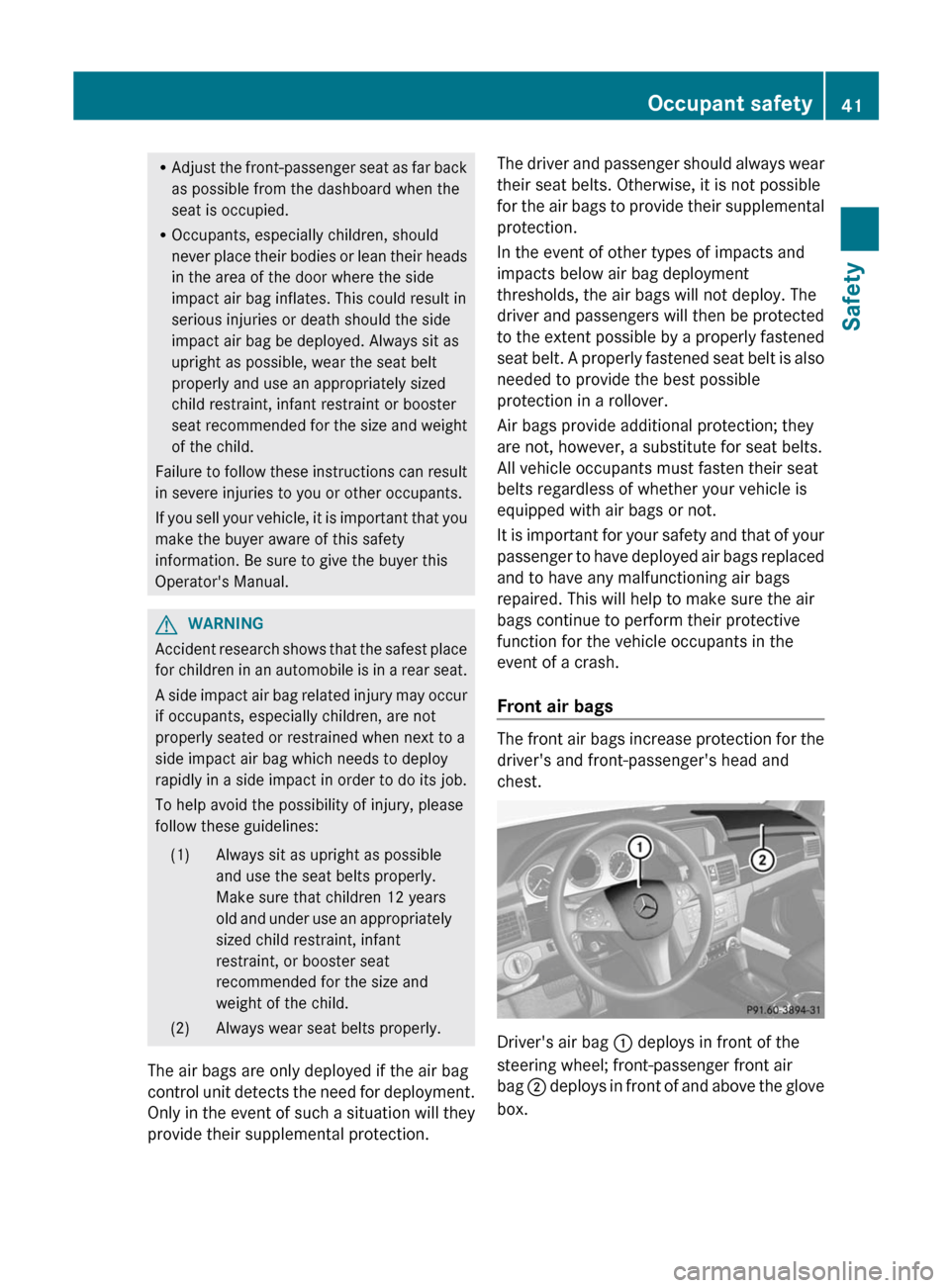
RAdjust the front-passenger seat as far back
as possible from the dashboard when the
seat is occupied.
R Occupants, especially children, should
never place their bodies or lean their heads
in the area of the door where the side
impact air bag inflates. This could result in
serious injuries or death should the side
impact air bag be deployed. Always sit as
upright as possible, wear the seat belt
properly and use an appropriately sized
child restraint, infant restraint or booster
seat recommended for the size and weight
of the child.
Failure to follow these instructions can result
in severe injuries to you or other occupants.
If you sell your vehicle, it is important that you
make the buyer aware of this safety
information. Be sure to give the buyer this
Operator's Manual.GWARNING
Accident research shows that the safest place
for children in an automobile is in a rear seat.
A side impact air bag related injury may occur
if occupants, especially children, are not
properly seated or restrained when next to a
side impact air bag which needs to deploy
rapidly in a side impact in order to do its job.
To help avoid the possibility of injury, please
follow these guidelines:
(1)Always sit as upright as possible
and use the seat belts properly.
Make sure that children 12 years
old and under use an appropriately
sized child restraint, infant
restraint, or booster seat
recommended for the size and
weight of the child.(2)Always wear seat belts properly.
The air bags are only deployed if the air bag
control unit detects the need for deployment.
Only in the event of such a situation will they
provide their supplemental protection.
The driver and passenger should always wear
their seat belts. Otherwise, it is not possible
for the air bags to provide their supplemental
protection.
In the event of other types of impacts and
impacts below air bag deployment
thresholds, the air bags will not deploy. The
driver and passengers will then be protected
to the extent possible by a properly fastened
seat belt. A properly fastened seat belt is also
needed to provide the best possible
protection in a rollover.
Air bags provide additional protection; they
are not, however, a substitute for seat belts.
All vehicle occupants must fasten their seat
belts regardless of whether your vehicle is
equipped with air bags or not.
It is important for your safety and that of your
passenger to have deployed air bags replaced
and to have any malfunctioning air bags
repaired. This will help to make sure the air
bags continue to perform their protective
function for the vehicle occupants in the
event of a crash.
Front air bags
The front air bags increase protection for the
driver's and front-passenger's head and
chest.
Driver's air bag : deploys in front of the
steering wheel; front-passenger front air
bag ; deploys in front of and above the glove
box.
Occupant safety41SafetyZ
Page 44 of 316
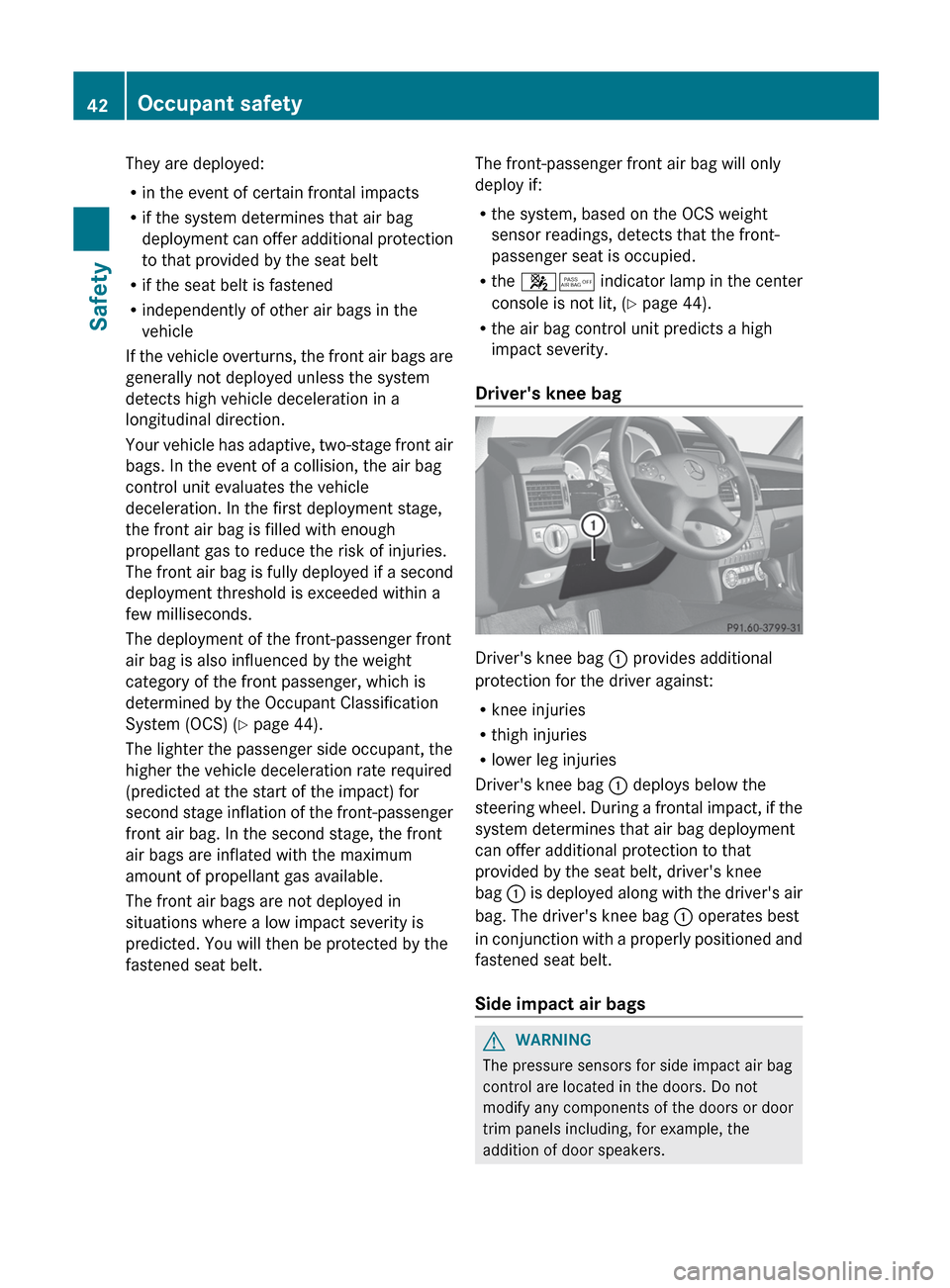
They are deployed:
R in the event of certain frontal impacts
R if the system determines that air bag
deployment can offer additional protection
to that provided by the seat belt
R if the seat belt is fastened
R independently of other air bags in the
vehicle
If the vehicle overturns, the front air bags are
generally not deployed unless the system
detects high vehicle deceleration in a
longitudinal direction.
Your vehicle has adaptive, two-stage front air
bags. In the event of a collision, the air bag
control unit evaluates the vehicle
deceleration. In the first deployment stage,
the front air bag is filled with enough
propellant gas to reduce the risk of injuries.
The front air bag is fully deployed if a second
deployment threshold is exceeded within a
few milliseconds.
The deployment of the front-passenger front
air bag is also influenced by the weight
category of the front passenger, which is
determined by the Occupant Classification
System (OCS) ( Y page 44).
The lighter the passenger side occupant, the
higher the vehicle deceleration rate required
(predicted at the start of the impact) for
second stage inflation of the front-passenger
front air bag. In the second stage, the front
air bags are inflated with the maximum
amount of propellant gas available.
The front air bags are not deployed in
situations where a low impact severity is
predicted. You will then be protected by the
fastened seat belt.The front-passenger front air bag will only
deploy if:
R the system, based on the OCS weight
sensor readings, detects that the front-
passenger seat is occupied.
R the 45 indicator lamp in the center
console is not lit, ( Y page 44).
R the air bag control unit predicts a high
impact severity.
Driver's knee bag
Driver's knee bag : provides additional
protection for the driver against:
R knee injuries
R thigh injuries
R lower leg injuries
Driver's knee bag : deploys below the
steering wheel. During a frontal impact, if the
system determines that air bag deployment
can offer additional protection to that
provided by the seat belt, driver's knee
bag : is deployed along with the driver's air
bag. The driver's knee bag : operates best
in conjunction with a properly positioned and
fastened seat belt.
Side impact air bags
GWARNING
The pressure sensors for side impact air bag
control are located in the doors. Do not
modify any components of the doors or door
trim panels including, for example, the
addition of door speakers.
42Occupant safetySafety
Page 46 of 316
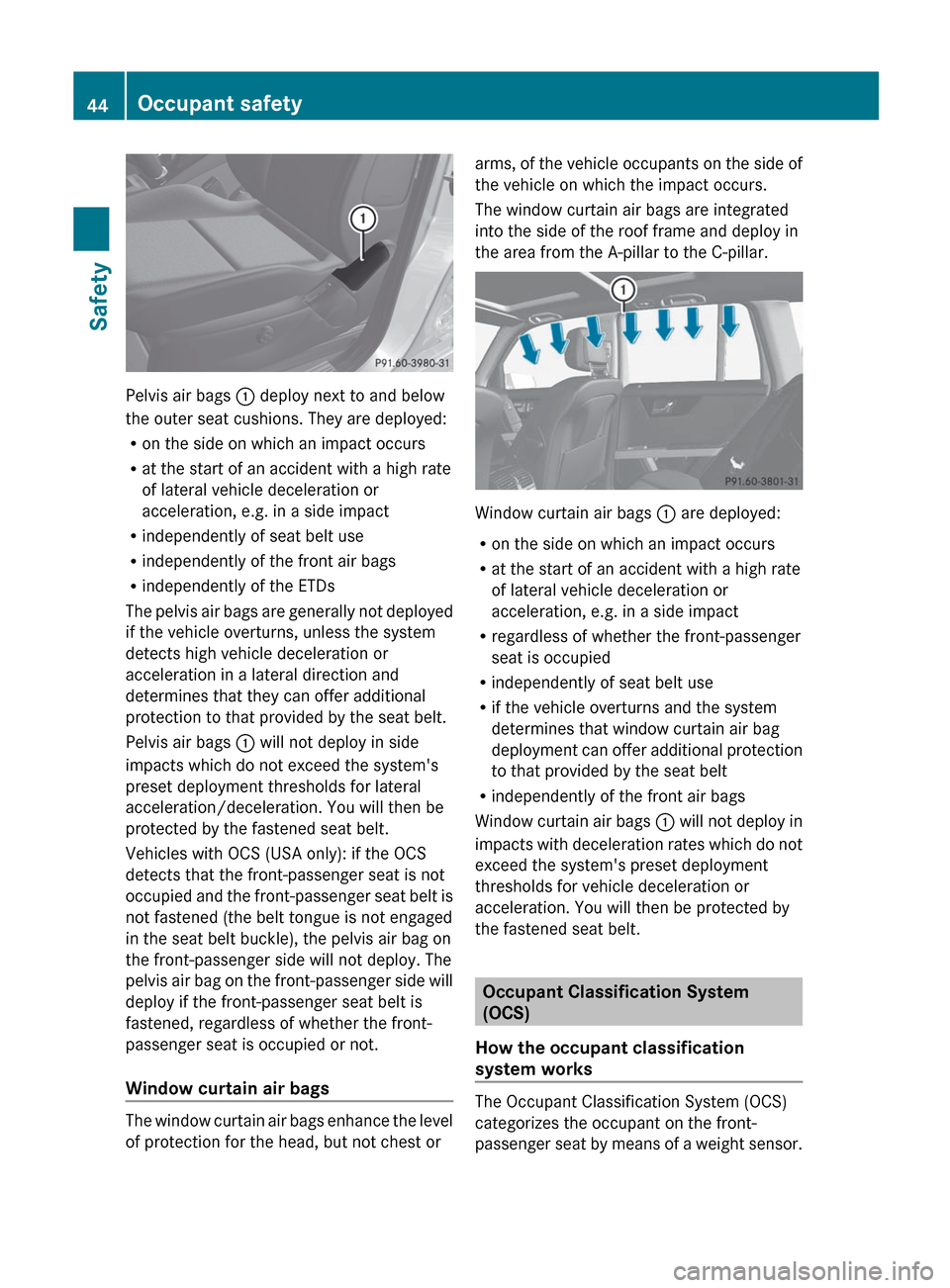
Pelvis air bags : deploy next to and below
the outer seat cushions. They are deployed:
R on the side on which an impact occurs
R at the start of an accident with a high rate
of lateral vehicle deceleration or
acceleration, e.g. in a side impact
R independently of seat belt use
R independently of the front air bags
R independently of the ETDs
The pelvis air bags are generally not deployed
if the vehicle overturns, unless the system
detects high vehicle deceleration or
acceleration in a lateral direction and
determines that they can offer additional
protection to that provided by the seat belt.
Pelvis air bags : will not deploy in side
impacts which do not exceed the system's
preset deployment thresholds for lateral
acceleration/deceleration. You will then be
protected by the fastened seat belt.
Vehicles with OCS (USA only): if the OCS
detects that the front-passenger seat is not
occupied and the front-passenger seat belt is
not fastened (the belt tongue is not engaged
in the seat belt buckle), the pelvis air bag on
the front-passenger side will not deploy. The
pelvis air bag on the front-passenger side will
deploy if the front-passenger seat belt is
fastened, regardless of whether the front-
passenger seat is occupied or not.
Window curtain air bags
The window curtain air bags enhance the level
of protection for the head, but not chest or
arms, of the vehicle occupants on the side of
the vehicle on which the impact occurs.
The window curtain air bags are integrated
into the side of the roof frame and deploy in
the area from the A-pillar to the C-pillar.
Window curtain air bags : are deployed:
R on the side on which an impact occurs
R at the start of an accident with a high rate
of lateral vehicle deceleration or
acceleration, e.g. in a side impact
R regardless of whether the front-passenger
seat is occupied
R independently of seat belt use
R if the vehicle overturns and the system
determines that window curtain air bag
deployment can offer additional protection
to that provided by the seat belt
R independently of the front air bags
Window curtain air bags : will not deploy in
impacts with deceleration rates which do not
exceed the system's preset deployment
thresholds for vehicle deceleration or
acceleration. You will then be protected by
the fastened seat belt.
Occupant Classification System
(OCS)
How the occupant classification
system works
The Occupant Classification System (OCS)
categorizes the occupant on the front-
passenger seat by means of a weight sensor.
44Occupant safetySafety
Page 47 of 316
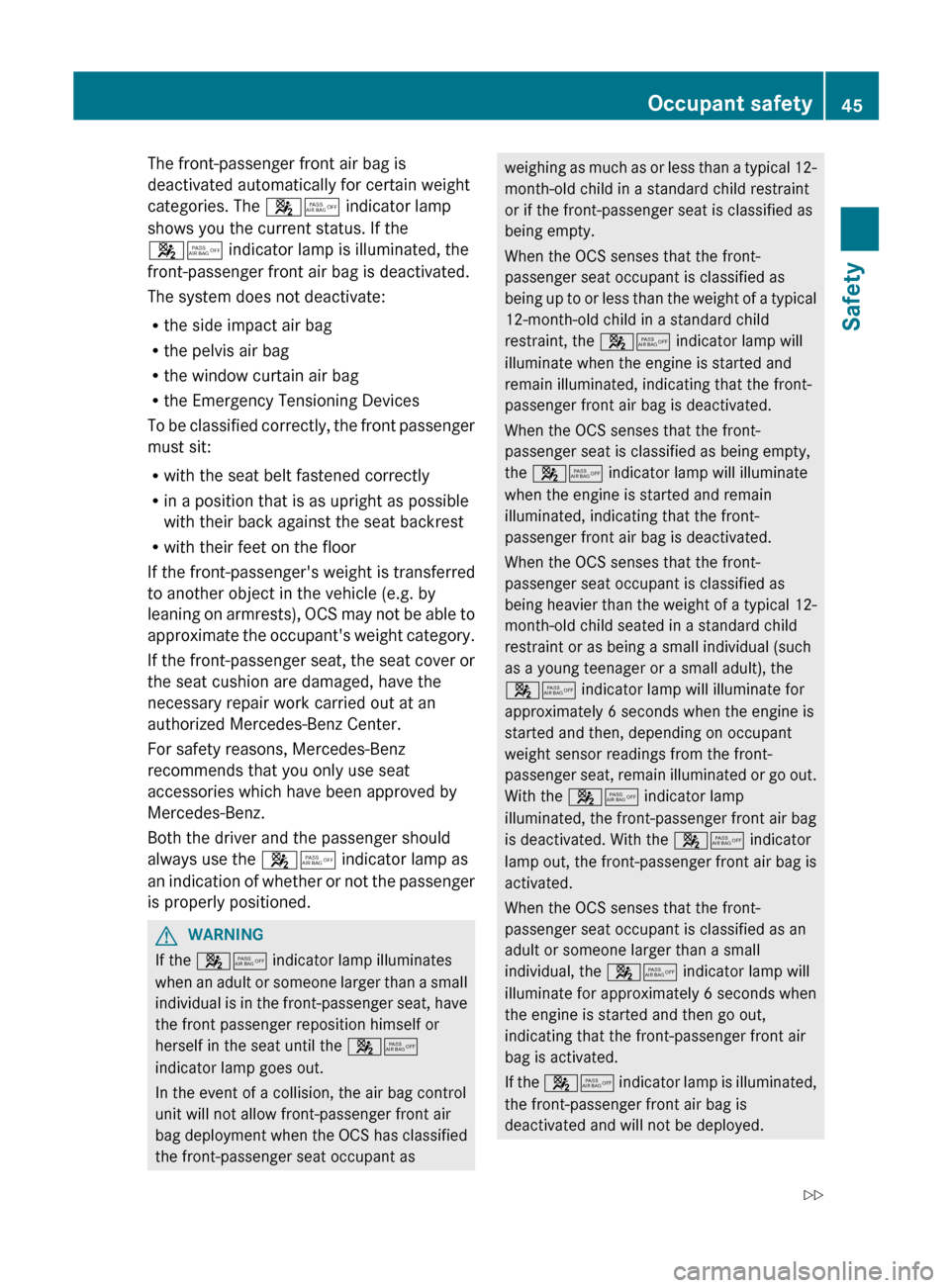
The front-passenger front air bag is
deactivated automatically for certain weight
categories. The 45 indicator lamp
shows you the current status. If the
45 indicator lamp is illuminated, the
front-passenger front air bag is deactivated.
The system does not deactivate:
R the side impact air bag
R the pelvis air bag
R the window curtain air bag
R the Emergency Tensioning Devices
To be classified correctly, the front passenger
must sit:
R with the seat belt fastened correctly
R in a position that is as upright as possible
with their back against the seat backrest
R with their feet on the floor
If the front-passenger's weight is transferred
to another object in the vehicle (e.g. by
leaning on armrests), OCS may not be able to
approximate the occupant's weight category.
If the front-passenger seat, the seat cover or
the seat cushion are damaged, have the
necessary repair work carried out at an
authorized Mercedes-Benz Center.
For safety reasons, Mercedes-Benz
recommends that you only use seat
accessories which have been approved by
Mercedes-Benz.
Both the driver and the passenger should
always use the 45 indicator lamp as
an indication of whether or not the passenger
is properly positioned.GWARNING
If the 45 indicator lamp illuminates
when an adult or someone larger than a small
individual is in the front-passenger seat, have
the front passenger reposition himself or
herself in the seat until the 45
indicator lamp goes out.
In the event of a collision, the air bag control
unit will not allow front-passenger front air
bag deployment when the OCS has classified
the front-passenger seat occupant as
weighing as much as or less than a typical 12-
month-old child in a standard child restraint
or if the front-passenger seat is classified as
being empty.
When the OCS senses that the front-
passenger seat occupant is classified as
being up to or less than the weight of a typical
12-month-old child in a standard child
restraint, the 45 indicator lamp will
illuminate when the engine is started and
remain illuminated, indicating that the front-
passenger front air bag is deactivated.
When the OCS senses that the front-
passenger seat is classified as being empty,
the 45 indicator lamp will illuminate
when the engine is started and remain
illuminated, indicating that the front-
passenger front air bag is deactivated.
When the OCS senses that the front-
passenger seat occupant is classified as
being heavier than the weight of a typical 12-
month-old child seated in a standard child
restraint or as being a small individual (such
as a young teenager or a small adult), the
45 indicator lamp will illuminate for
approximately 6 seconds when the engine is
started and then, depending on occupant
weight sensor readings from the front-
passenger seat, remain illuminated or go out.
With the 45 indicator lamp
illuminated, the front-passenger front air bag
is deactivated. With the 45 indicator
lamp out, the front-passenger front air bag is
activated.
When the OCS senses that the front-
passenger seat occupant is classified as an
adult or someone larger than a small
individual, the 45 indicator lamp will
illuminate for approximately 6 seconds when
the engine is started and then go out,
indicating that the front-passenger front air
bag is activated.
If the 45 indicator lamp is illuminated,
the front-passenger front air bag is
deactivated and will not be deployed.Occupant safety45SafetyZ
Page 48 of 316
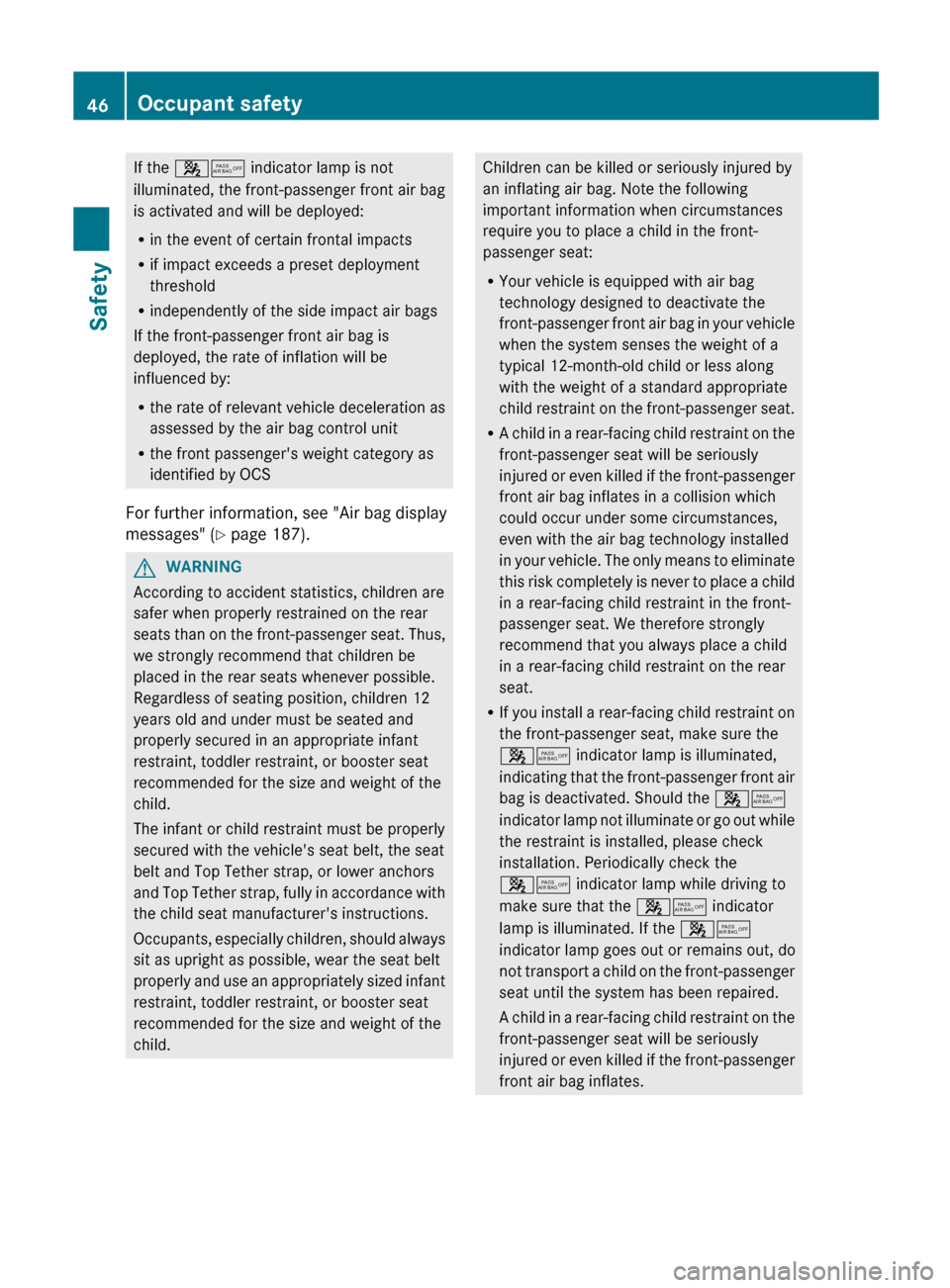
If the 45 indicator lamp is not
illuminated, the front-passenger front air bag
is activated and will be deployed:
R in the event of certain frontal impacts
R if impact exceeds a preset deployment
threshold
R independently of the side impact air bags
If the front-passenger front air bag is
deployed, the rate of inflation will be
influenced by:
R the rate of relevant vehicle deceleration as
assessed by the air bag control unit
R the front passenger's weight category as
identified by OCS
For further information, see "Air bag display
messages" ( Y page 187).GWARNING
According to accident statistics, children are
safer when properly restrained on the rear
seats than on the front-passenger seat. Thus,
we strongly recommend that children be
placed in the rear seats whenever possible.
Regardless of seating position, children 12
years old and under must be seated and
properly secured in an appropriate infant
restraint, toddler restraint, or booster seat
recommended for the size and weight of the
child.
The infant or child restraint must be properly
secured with the vehicle's seat belt, the seat
belt and Top Tether strap, or lower anchors
and Top Tether strap, fully in accordance with
the child seat manufacturer's instructions.
Occupants, especially children, should always
sit as upright as possible, wear the seat belt
properly and use an appropriately sized infant
restraint, toddler restraint, or booster seat
recommended for the size and weight of the
child.
Children can be killed or seriously injured by
an inflating air bag. Note the following
important information when circumstances
require you to place a child in the front-
passenger seat:
R Your vehicle is equipped with air bag
technology designed to deactivate the
front-passenger front air bag in your vehicle
when the system senses the weight of a
typical 12-month-old child or less along
with the weight of a standard appropriate
child restraint on the front-passenger seat.
R A child in a rear-facing child restraint on the
front-passenger seat will be seriously
injured or even killed if the front-passenger
front air bag inflates in a collision which
could occur under some circumstances,
even with the air bag technology installed
in your vehicle. The only means to eliminate
this risk completely is never to place a child
in a rear-facing child restraint in the front-
passenger seat. We therefore strongly
recommend that you always place a child
in a rear-facing child restraint on the rear
seat.
R If you install a rear-facing child restraint on
the front-passenger seat, make sure the
45 indicator lamp is illuminated,
indicating that the front-passenger front air
bag is deactivated. Should the 45
indicator lamp not illuminate or go out while
the restraint is installed, please check
installation. Periodically check the
45 indicator lamp while driving to
make sure that the 45 indicator
lamp is illuminated. If the 45
indicator lamp goes out or remains out, do
not transport a child on the front-passenger
seat until the system has been repaired.
A child in a rear-facing child restraint on the
front-passenger seat will be seriously
injured or even killed if the front-passenger
front air bag inflates.46Occupant safetySafety
Page 49 of 316
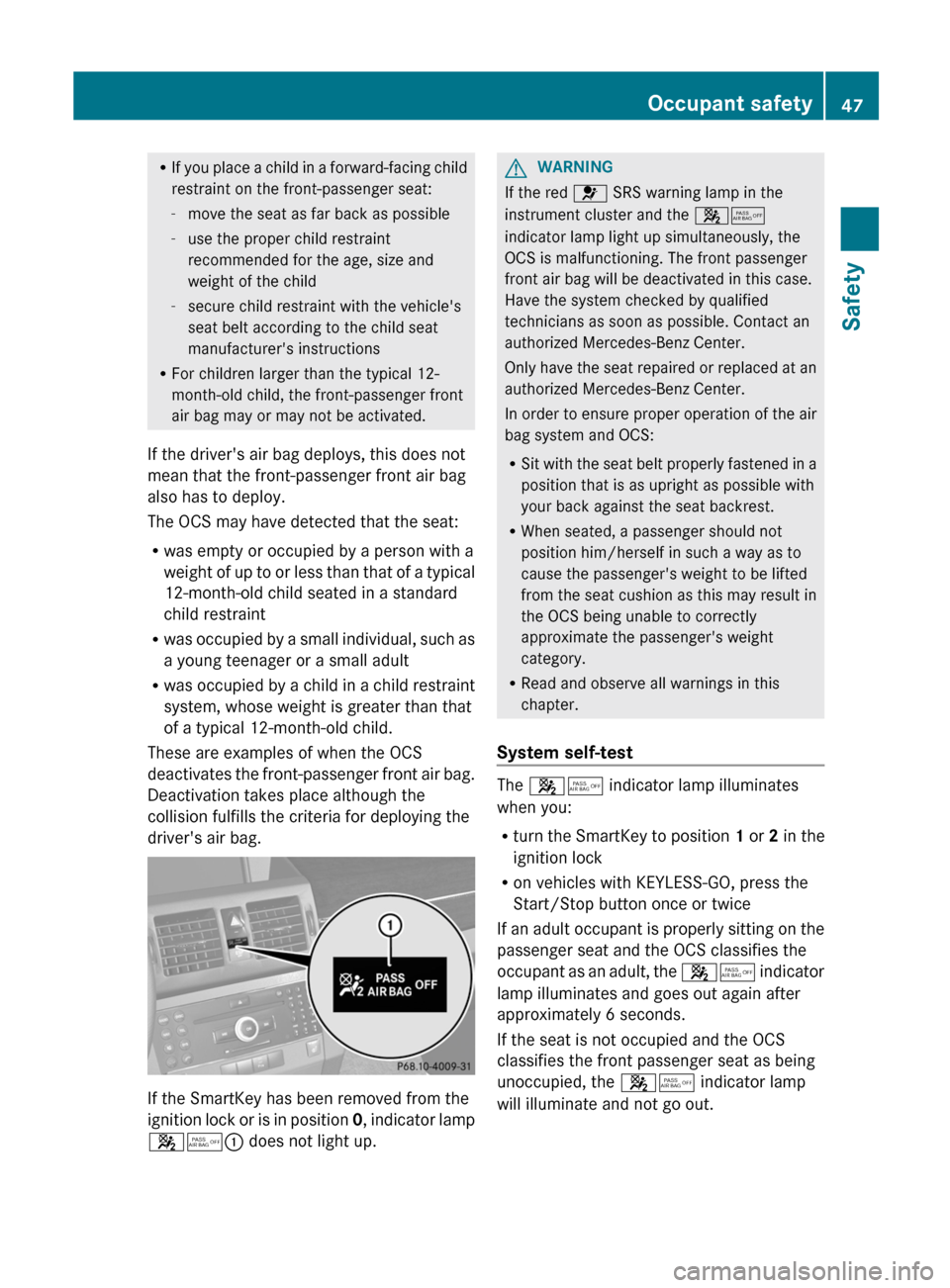
RIf you place a child in a forward-facing child
restraint on the front-passenger seat:
- move the seat as far back as possible
- use the proper child restraint
recommended for the age, size and
weight of the child
- secure child restraint with the vehicle's
seat belt according to the child seat
manufacturer's instructions
R For children larger than the typical 12-
month-old child, the front-passenger front
air bag may or may not be activated.
If the driver's air bag deploys, this does not
mean that the front-passenger front air bag
also has to deploy.
The OCS may have detected that the seat:
R was empty or occupied by a person with a
weight of up to or less than that of a typical
12-month-old child seated in a standard
child restraint
R was occupied by a small individual, such as
a young teenager or a small adult
R was occupied by a child in a child restraint
system, whose weight is greater than that
of a typical 12-month-old child.
These are examples of when the OCS
deactivates the front-passenger front air bag.
Deactivation takes place although the
collision fulfills the criteria for deploying the
driver's air bag.
If the SmartKey has been removed from the
ignition lock or is in position 0, indicator lamp
45 : does not light up.
GWARNING
If the red 6 SRS warning lamp in the
instrument cluster and the 45
indicator lamp light up simultaneously, the
OCS is malfunctioning. The front passenger
front air bag will be deactivated in this case.
Have the system checked by qualified
technicians as soon as possible. Contact an
authorized Mercedes-Benz Center.
Only have the seat repaired or replaced at an
authorized Mercedes-Benz Center.
In order to ensure proper operation of the air
bag system and OCS:
R Sit with the seat belt properly fastened in a
position that is as upright as possible with
your back against the seat backrest.
R When seated, a passenger should not
position him/herself in such a way as to
cause the passenger's weight to be lifted
from the seat cushion as this may result in
the OCS being unable to correctly
approximate the passenger's weight
category.
R Read and observe all warnings in this
chapter.
System self-test
The 45 indicator lamp illuminates
when you:
R turn the SmartKey to position 1 or 2 in the
ignition lock
R on vehicles with KEYLESS-GO, press the
Start/Stop button once or twice
If an adult occupant is properly sitting on the
passenger seat and the OCS classifies the
occupant as an adult, the 45 indicator
lamp illuminates and goes out again after
approximately 6 seconds.
If the seat is not occupied and the OCS
classifies the front passenger seat as being
unoccupied, the 45 indicator lamp
will illuminate and not go out.
Occupant safety47SafetyZ
Page 51 of 316
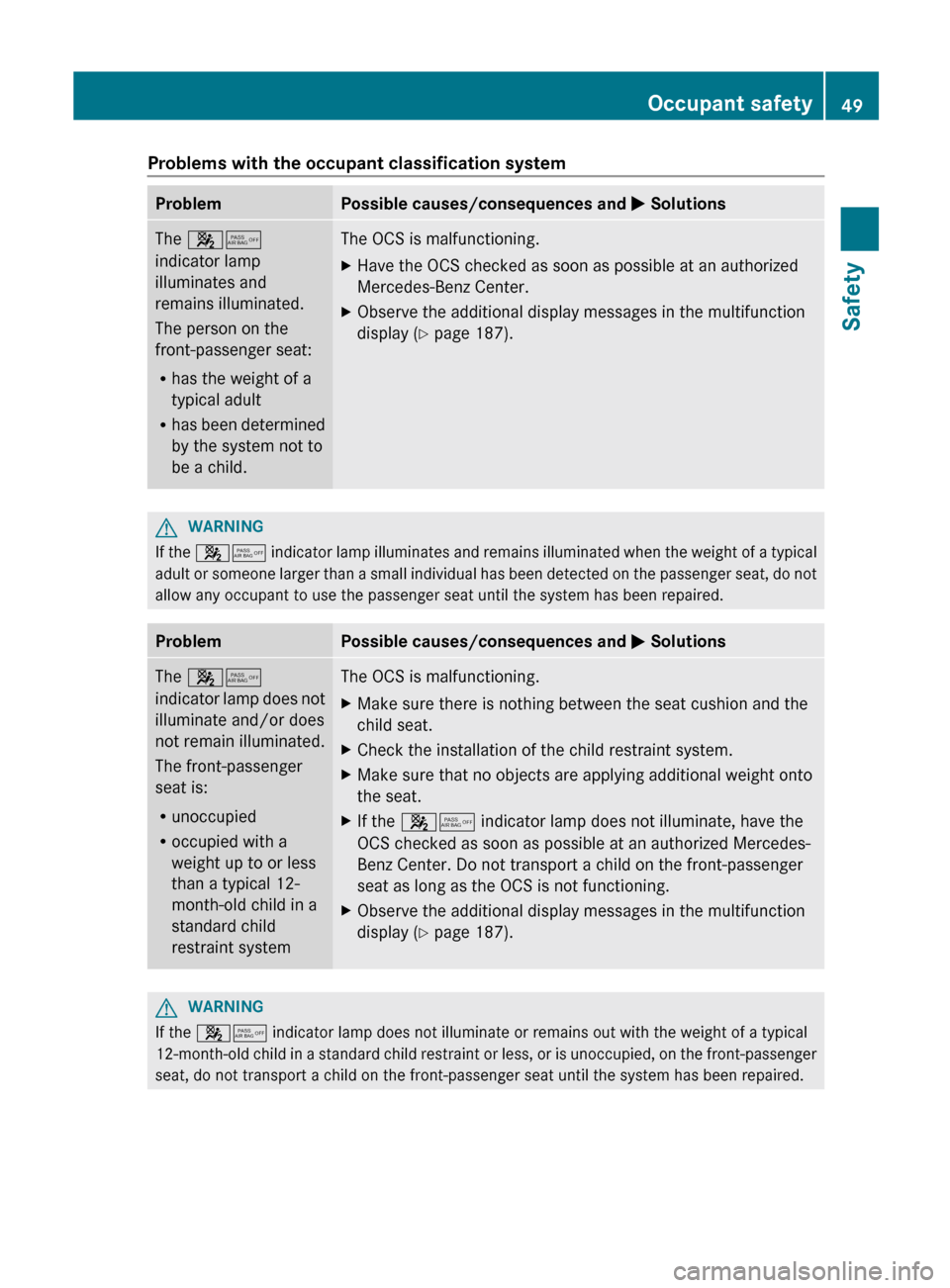
Problems with the occupant classification systemProblemPossible causes/consequences and M SolutionsThe 45
indicator lamp
illuminates and
remains illuminated.
The person on the
front-passenger seat:
R has the weight of a
typical adult
R has been determined
by the system not to
be a child.The OCS is malfunctioning.XHave the OCS checked as soon as possible at an authorized
Mercedes-Benz Center.XObserve the additional display messages in the multifunction
display ( Y page 187).GWARNING
If the 45 indicator lamp illuminates and remains illuminated when the weight of a typical
adult or someone larger than a small individual has been detected on the passenger seat, do not
allow any occupant to use the passenger seat until the system has been repaired.
ProblemPossible causes/consequences and M SolutionsThe 45
indicator lamp does not
illuminate and/or does
not remain illuminated.
The front-passenger
seat is:
R unoccupied
R occupied with a
weight up to or less
than a typical 12-
month-old child in a
standard child
restraint systemThe OCS is malfunctioning.XMake sure there is nothing between the seat cushion and the
child seat.XCheck the installation of the child restraint system.XMake sure that no objects are applying additional weight onto
the seat.XIf the 45 indicator lamp does not illuminate, have the
OCS checked as soon as possible at an authorized Mercedes-
Benz Center. Do not transport a child on the front-passenger
seat as long as the OCS is not functioning.XObserve the additional display messages in the multifunction
display ( Y page 187).GWARNING
If the 45 indicator lamp does not illuminate or remains out with the weight of a typical
12-month-old child in a standard child restraint or less, or is unoccupied, on the front-passenger
seat, do not transport a child on the front-passenger seat until the system has been repaired.
Occupant safety49SafetyZ